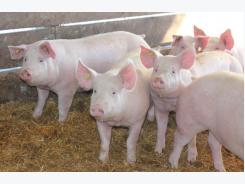Benefits of corn co-products from wet milling for pigs

Researchers have reported that using corn co-products from wet milling can be beneficial to pig diets. Corn co-products have a much higher concentration of fibre compared to corn. Hans Stein explains the results.
Many co-products from the corn processing industry may be used in diets fed to pigs. Much attention over the last 10 years has been on co-products produced from the biofuels industry, including distillers dried grains and high-protein distillers grains. However, the wet milling industry also produces many different co-products that may be used in pig diets.
Because little information about co-products produced from the wet milling industry has been reported, research from the University of Illinois is helping to determine the nutritional value of four of these co-products so that producers and companies can incorporate these ingredients into swine diets, said Hans H. Stein, a U of I animal science researcher.
Corn co-products and what the study entailed
Researchers, led by Stein, conducted two experiments using corn and four co-products, which included: high-fat corn germ (HFCG); corn bran; liquid corn extractives (LCE); and LCE added to corn germ meal (CGM-LCE). The experiments were conducted to determine the energy concentration and amino acid digestibility.
Stein explained that HFCG is a high-fat product (30% fat), which compares to only 3% fat in corn. Corn bran is high in fibre but low in fat. Liquid corn extractive is a liquid product usually not used as feed alone, but often added to corn gluten feed. During the experiments, the researchers added LCE to corn germ meal to create a new product from the corn processing stream that could be used as feed.
Corn contained 3,986 kilocalories of digestible energy (DE) per kilogram of dry matter, more than any of the other ingredients. The digestible energy in the remaining products was similar in HFCG (3,631 kcal/kg), LCE (3,485 kcal/kg), and CGM-LCE (3,567 kcal/kg), with the lowest in corn bran (3,205 kcal/kg). Corn also had the greatest concentration of metabolisable energy (ME) at 3,871 kcal/kg dry matter, followed by HFCG (3,336 kcal/kg), CGM-LCE (3,272 kcal.kg), LCE (3,102 kcal/kg), and corn bran (3,077 kcal/kg).
The results from the study on corn co-products
"The lower concentration of DE and ME in the corn co-products was not surprising because all these co-products have a much higher fibre concentration than corn," Stein said. "They are all lower energy than corn, but that doesn't mean we can't use them because there are some circumstances when we want lower energy, such as in diets for gestating sows. We don't want gestating sows to overeat high-energy products so it is good to have a high-fibre ingredient. Corn germ meal is very good for sows, and we can also utilise quite a bit of these ingredients in growing pig diets."
Amino acid digestibility was reduced with the corn co-products compared with corn. Total AA digestibility was greater than 75% in corn, with CGM-LCE, HFCG, and LCE greater than 50%. The AA digestibility in corn bran was less than 50%.
"We observed that there are reductions in amino acid digestibility in all the co-products compared with corn. That will require using more soybean meal or another protein source if any of these ingredients are used," Stein explained.
With the results of this research, nutritionists can now formulate diets using the co-products from the wet milling industry said Stein. "By adding LCE to corn germ meal, we attempt to add value to both co-products," Stein said. "This illustrates how many different options there are in corn. It is an amazing crop."
"Energy concentration and amino acid digestibility in corn and corn co-products from the wet-milling industry fed to growing pigs" was recently published in the Journal of Animal Science. Co-authors of the study include Y. Liu, M. Song, F.N. Almeida, and H. Stein of the University of Illinois, and S.L. Tilton, M.J. Cecava of Archer Daniels Midland Company, Decatur, IL.
Archer Daniels Midland Company ADM provided funding for this study.
Related news
Tools

Phối trộn thức ăn chăn nuôi

Pha dung dịch thủy canh

Định mức cho tôm ăn

Phối trộn phân bón NPK

Xác định tỷ lệ tôm sống

Chuyển đổi đơn vị phân bón

Xác định công suất sục khí

Chuyển đổi đơn vị tôm

Tính diện tích nhà kính

Tính thể tích ao



 Prevention of the disease caused by Actinobacillus pleuropneumoniae
Prevention of the disease caused by Actinobacillus pleuropneumoniae  Piglets can thrive on sunflower meal
Piglets can thrive on sunflower meal